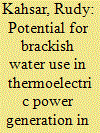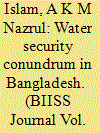| Srl | Item |
| 1 |
ID:
123447


|
|
|
|
|
| Publication |
2013.
|
| Summary/Abstract |
The problems of agriculture in India are shared by many developing, densely populated countries, especially those located in the tropical belt of the planet. Konda Reddy Chavva and C Sheela Reddy point out that liberal reforms dictated by the IMF deprived farmers of much needed government support, prompting many to fall into a vicious cycle of indebtedness and cash crop monoculture, vulnerable to international price fluctuations.
|
|
|
|
|
|
|
|
|
|
|
|
|
|
|
|
| 2 |
ID:
171415


|
|
|
|
|
| Summary/Abstract |
Threatened by a changing climate and the increased frequency of droughts and heat waves, more attention is being given to the sourcing of water resources. Especially in the American southwest, the frequency and severity of water shortages as well as elevated surface water temperatures has resulted in a series of threatened or imposed curtailments of thermoelectric power, the largest withdrawer of water in the United States. These cuts in generation can have important implications for the reliability and dispatchability of electric power, especially in summer months when electricity is needed most. This paper examines the potential for using brackish groundwater as a supplemental water source for thermoelectric power generation in seventeen western states and finds that the conversion of drought prone facilities to brackish backup systems would cost on the order of 60–70 thousand dollars per installed megawatt. Action from the federal government to foster basic research and technology readiness combined with state level action to require water resource contingency planning would encourage deployment of brackish water backup systems that would subsequently ensure resiliency and reliability of thermal generation during heat waves and in times of drought.
|
|
|
|
|
|
|
|
|
|
|
|
|
|
|
|
| 3 |
ID:
117742


|
|
|
|
|
| Publication |
2012.
|
| Summary/Abstract |
At the global level, use of water has increased significantly and it is on the rise, while its availability and access have reduced. Water is inherently linked to the growing challenges of the present day civilisation that include food security, health, economic growth, and poverty alleviation. In Bangladesh, availability of and access to water have appeared to be a significant obstruction to the survival and livelihood of its people and, sustainable economic growth of the country. Being the lowest riparian country in the Eastern Himalayan River systems, the water ecosystem of Bangladesh is vulnerable to unilateral upstream actions since a major share of surface water in the country comes from outside the border. This paper highlights that the main reason of Bangladesh water crises is the low flows of water due to upstream intervention by India which significantly affects surface water availability in Bangladesh during the dry period. Thus, during the dry period there always remains a gap between the need and availability. There is an increasing dependence on the use of groundwater which is depleting very fast due to over exploitation by a huge population. Climate change is likely to worsen the situation further. Due to severe gaps between the demand and supply of water there is a distressing impact on the live and livelihood of the population of Bangladesh which are manifested on the environment/non-traditional security sphere of the country. These, in course of time are likely to be posing severe threat to the security and stability of the country. The paper concludes that the management of common water resources taking into account the totality of Bangladesh-India common rivers could hardly be achieved without the involvement of all other stake holders which may include the Eastern Himalayan River systems co-basin states, particularly Nepal and Bhutan.
|
|
|
|
|
|
|
|
|
|
|
|
|
|
|
|